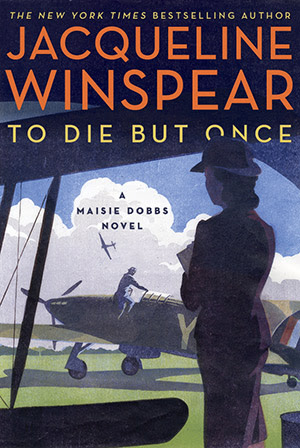It’s on it’s way! If you’re a Maisie Dobbs fan, you’ll be happy to learn the latest book in the series, To Die But Once, will be released March 27. You can pre-order a signed copy through the Web Store. https://bit.ly/2mgAgl1
And, I would have linked to Jacqueline Winspear’s newsletter in which she discusses the background of the book, but the newsletter isn’t up on her website yet. So, I’ll just have to share. The formatting is off because it was taken from my email, but the information is worth sharing.
 |
||
|
As this is my first newsletter of the year, I would like to wish you all the very best in 2018. May your days be filled with joy, peace, contentment, love and good health—and anything else on your dream list!
As soon as January rolls around, the final countdown to publication of a new novel in the Maisie Dobbs’ series begins. TO DIE BUT ONCE will be published on March 27th this year, with the accompanying book tour kicking off in Houston on March 26th. I’ll have the full details soon, and will post dates and event locations on my Facebook page as well as on my website and indeed in my next newsletter.
The main story underpinning TO DIE BUT ONCE—that of the young apprentice—was inspired by my father’s experiences during the early part of the war. Dad was fourteen in 1940, but had left school earlier because he was tapped to be a “runner” between ARP (Air Raid Precautions) and military posts in south London. The ARP men went around to the schools, picking out the best sprinters for the job—and Dad was the fastest runner in the school. But having run though burning bomb-sites during the early part of the Blitz, he must have been relieved when he began an apprenticeship later in 1940, soon after he turned fourteen—the age at which you started full-time work in those days. I knew my father had a job that took him from place to place around the country before he joined the army, but I didn’t really know the details until his last weeks. During those hours in the hospice, when we’d watch his favorite TV shows, talk about a book he was reading, or discuss the news, Dad also told me stories of his childhood in London. It was a lovely, precious, yet bittersweet time. He also told me more about that job, and I became even more curious as he described his work to me, and what was involved in using a brand new type of emulsion to paint the buildings at military airfields around Britain. “It was amazing,” he said. “After we finished painting each building we had to test the surface, so we’d stand a line of four blowtorches right up against the wall, and let them run for three or four hours. The first time, well, we couldn’t believe our eyes—there was not a mark on the wall, no burn marks, no bubbling of the paint, nothing.” I was shocked and asked what the paint was called. “Oh, it didn’t have a name,” he replied. “Just a number.” Many of those airfields were situated in southern England where much of TO DIE BUT ONCE is set, though the job took him all over the country. By coincidence, one of my cousins lives in a region where Dad was billeted for a while. It was when my cousin told me about the area’s links to the Bank of England during the war, that I knew a story was coming together.
In the next pre-publication newsletter, I’ll be telling you about other themes you’ll find in TO DIE BUT ONCE, and how they were inspired by family stories of the Second World War. With all good wishes, Jacqueline |
||



